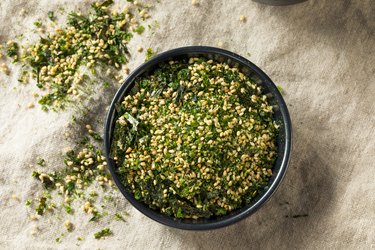
Over 90 percent of Americans eat more than the recommended amount of sodium every day. While the Dietary Guidelines for Americans suggest we shouldn't take in more than 2,300 milligrams per day, most of us get an average of 3,400 milligrams daily.
Translation: You're probably eating nearly 50 percent more than the recommended daily allowance for sodium every single day.
Video of the Day
Video of the Day
"A diet too high in sodium can increase the risk of high blood pressure, heart failure, certain cancers, osteoporosis, kidney disease and stroke," says Erin Coates, RDN, a dietitian at the Cleveland Clinic. And eating less of the salty stuff comes with benefits: Restricting dietary sodium was associated with decreased arterial stiffness, a primary risk factor for high blood pressure, heart disease and stroke, according to an April 2018 review published in the Journal of Hypertension.
But if you can't help cooking with salt or adding it to your meals, there's actually a super-easy way to cut down on salt while still enjoying that savory flavor you love. All you have to do is ditch the salt shaker and replace it with one of our favorite natural flavor enhancers that hails from the sea.
How Does Seaweed Taste?
You'll be surprised to find out that seaweed flakes such as dulce and kelp actually don't have a fishy taste. They're salty, but not as salty as pure salt, and pack an umami flavor that can be added to a variety of dishes.
The Benefits of Using Seaweed Over Salt
Here's a superfood to tap if you're looking to dial back your sodium: seaweed. Yep, the marine algae is more than just a convenient wrap for your favorite sushi roll.
When dried and flaked, seaweed becomes a no-brainer condiment. Unlike table salt, the plant serves up a host of nutritional benefits. "Seaweed contains iodine, iron, magnesium, fiber, calcium, zinc and vitamins like B12," Coates says. "Most importantly, seaweed also contains potassium."
You'll benefit from a variety of different nutrients by swapping the salt in your shaker with some umami-rich seaweed.
You'll Still Get Iodine
Iodine is a mineral that's required for the functioning of thyroid hormones T3 and T4, which are involved in metabolism regulation, as well as brain development and bone maintenance. Back in the early 1920s, the U.S. government began fortifying table salt with iodine to fight widespread deficiencies — and it worked, according to a September 2017 article published in the journal Nutrients. Today, iodine deficiencies are rare, with some 70 percent of U.S. households using iodized salt.
Just one tablespoon of dulse flakes (a type of red seaweed) serves up 837 micrograms of iodine, or 557 percent of the daily value (DV), according to the USDA. That may sound like an excessive amount of the mineral, but the tolerable upper intake level for adults ages 19 and up is 1,100 micrograms of iodine per day, per the National Institutes of Health.
It Packs Fiber and Protein
One tablespoon packs one gram each of belly-filling fiber and plant-based protein, while salt contains zero of both nutrients. Fiber is important for everything from promoting gut health and stabilizing blood sugar levels to helping lower cholesterol.
Seaweed Contains Less Sodium
However, note that seaweed does contain some naturally occurring salt, with 87 milligrams of sodium per tablespoon. For reference, one teaspoon of table salt contains about 2,300 milligrams of sodium — the maximum amount we should be eating per day.
You'll Get Potassium
That same one tablespoon of dulse flakes also offers up 11 percent of the DV of potassium. This is important because the majority of Americans don't get enough potassium, which is most concentrated in foods like fruits, vegetables and dairy.
"A higher potassium diet can help remove excess sodium from the body because potassium works to relieve tension in the blood vessels' walls, which aids in lowering blood pressure and reducing the risk of stroke," Coates notes. The body requires both sodium and potassium to maintain proper fluid balance and blood volume.
Warning
Not everyone requires more potassium. People with chronic kidney disease, for example, are often potassium restricted due to the kidneys’ inability to rid the body of the mineral. Always talk to your doctor or a registered dietitian before making changes to your diet if you have any medical conditions.
Read more: What Are Side Effects of Eating Seaweed?
Seaweed Recipes to Try
Seaweed Brands to Buy
Seaweed's naturally briny flavor lends itself to a wide range of savory meals. Coates suggests throwing dulse or seaweed granules into soups, chowders, salads and cooked potatoes for a tasty, low-sodium seasoning.
1. Nora Seaweed Snacks
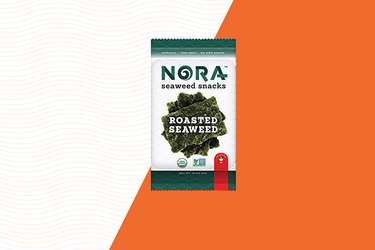
Buy it: Amazon.com; Price: $14.99 per 12-pack
2. Maine Coast Sea Vegetables Dulse Flakes
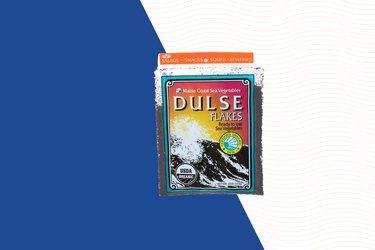
Buy it: Amazon.com; Price: $14.81 per 4-ounce bag
3. One Organic Roasted Seaweed Sheets
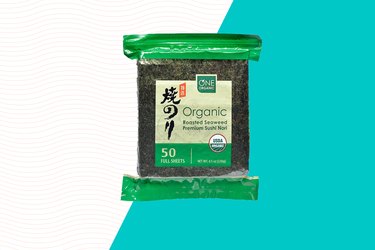
Buy it: Amazon.com; Price: $13.95 per pack
4. Mary’s Gone Crackers Superseed Seaweed and Black Sesame Crackers
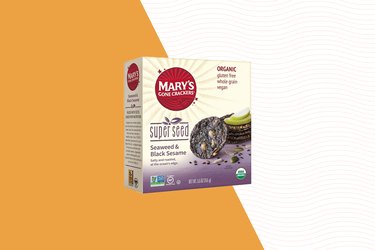
Buy it: Amazon.com; Price: $4.44 per pack
Read more: 9 Delicious DASH Diet-Friendly Recipes
- Journal of Hypertension: “Effect of Dietary Sodium Restriction on Arterial Stiffness: Systematic Review and Meta-Analysis of the Randomized Controlled Trials”
- Centers for Disease Control and Prevention: “Get the Facts: Sodium and the Dietary Guidelines”`
- FoodData Central: “Dulse Flakes”
- Nutrients: “History of U.S. Iodine Fortification and Supplementation”
- National Institutes of Health: “Iodine Fact Sheet for Health Professionals”
- Office of Disease Prevention and Health Promotion: “2015-2020 Dietary Guidelines for Americans”
Was this article helpful?
150 Characters Max
0/150
Thank you for sharing!
Thank you for your feedback!